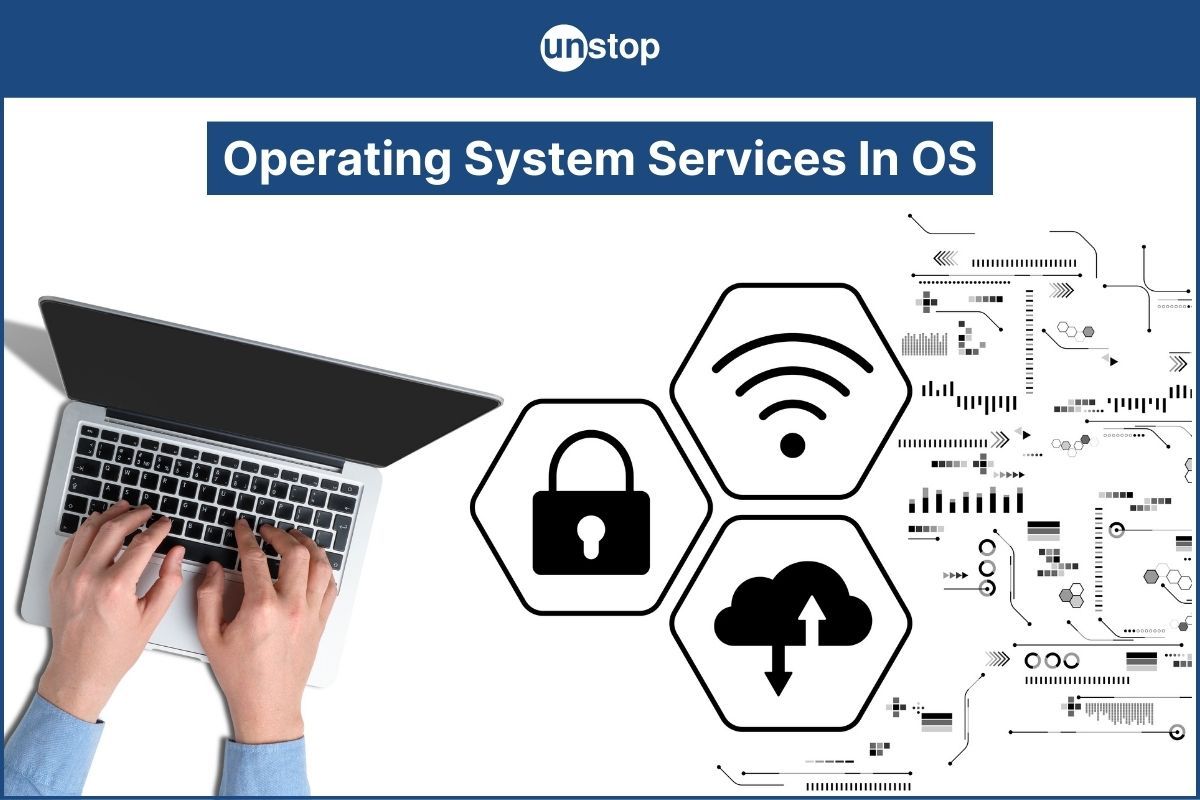- Overview Of Operating System Services
- User Interface In Operating System Services
- Program Execution & Management In OS Services
- File System Manipulation & Organization In OS Services
- Input & Output Operations In OS
- Communication Systems Within OS
- Error Detection & Response Mechanisms
- Security & Privacy Measures in OS
- Memory & Process Management In OS
- Frequently Asked Questions (FAQs)
Operating System Services | Different Services Of OS Explained

Operating system services play a vital role in managing computer resources efficiently. These services encompass essential functions like process management, memory management, file system access, and device communication.
Overview Of Operating System Services
To begin with, let us look at the overview of operating system services:
Essential Functions
Operating system (OS) services control computer hardware and software resources. These services ensure that resources are used efficiently to execute user applications effectively. These system services play a vital role in managing various aspects of a computer's operation.
For instance, a service like process management oversees the creation and termination of processes within the operating system.
Memory management ensures that each program running on the computer has enough memory space to function correctly.
Resource Utilization
By overseeing these critical functions, operating system services prevent conflicts between different programs vying for the same resources.
They allocate resources based on priority levels set by the operating system to guarantee smooth operations across all applications.
User Interface In Operating System Services
Let us study the user interface in OS:
Graphical User Interfaces
Graphical user interfaces (GUIs) are a key component of operating system services. They present visual elements like icons, windows, and menus that users can interact with using a mouse or touchpad.

For example, when you click on an icon to open an application or drag and drop files into folders, you are utilizing the GUI features. GUIs make it simpler for users to navigate through the system without needing to remember complex commands.
Command-Line Interfaces
Command-line interfaces (CLIs) provide a text-based way for users to communicate with the operating system by typing specific commands. This interface type offers more control over system operations as users can execute precise instructions directly.
Program Execution & Management In OS Services
Let us study how OS services carry out program execution and management:
Major Activities
Operating system services involve major activities such as loading programs into memory, allocating resources for execution, and managing multiple processes simultaneously.
When a user initiates a program, the operating system takes charge of loading it into the computer's memory to facilitate its execution.
This process ensures that the program has access to the necessary resources to run efficiently.
Scheduling Processes
One of the activities that operating systems handle is scheduling processes effectively. By juggling various tasks running concurrently on a computer, they ensure fair resource allocation among programs.
For example, if multiple applications are running simultaneously on your device, the operating system manages their execution by prioritizing critical tasks and distributing resources accordingly.
Process Management
In terms of process management, operating systems monitor program behaviour, detect errors within processes, and terminate malfunctioning ones promptly. This monitoring helps maintain stability within the system by preventing one faulty program from affecting others or causing system crashes.
By terminating malfunctioning processes swiftly, operating systems uphold overall performance and prevent disruptions in user experience.
File System Manipulation & Organization In OS Services
Let us study the file system manipulation and organization in operating system services:
Facilitating File Manipulation
Operating system services encompass file system functions that allow users to create, delete, modify, and organize files and directories. These services establish hierarchical structures for efficient file organization. They provide features like file permissions and access control to ensure data security.
By offering these capabilities, operating systems enable users to interact with their files in a structured and secure manner.
Efficient Storage Allocation
One key aspect of file system manipulation is the efficient use of disk space through proper storage allocation techniques. Operating systems manage this by allocating just enough space for storing a file based on its size while preventing unnecessary wastage of disk space.
This ensures optimal usage of available storage resources.
Input & Output Operations In OS
Let us study the input and output operations in OS:
Managing Peripheral Devices
Operating system services encompass managing input/output operations between peripheral devices like keyboards, mice, and printers. These services ensure seamless communication between hardware devices and software applications through device drivers.
These device drivers act as intermediaries, facilitating data transfer between external peripherals and the computer's memory.
By overseeing these operations, operating systems guarantee efficient interaction with various external devices.
Ensuring Data Transfer Efficiency
Input and output operations are crucial for transferring data effectively between peripheral devices and the computer's memory. Through these processes, users can interact with different hardware components smoothly.
Communication Systems Within OS
Let us study the communication systems within the operating systems:
Facilitating Inter-Process Communication
Operating system services play a vital role in facilitating inter-process communication (IPC) within modern computer systems. IPC mechanisms such as shared memory, message passing, and synchronization primitives allow processes to communicate effectively.
These communication systems are essential for enabling processes to exchange data, coordinate actions, and collaborate efficiently.
Shared Memory
-
Processes can share data through a common memory area.
-
Offers fast communication between processes running on the same system.
Message Passing
-
Involves sending messages between processes.
-
Enables communication between processes on different computers over a network.
Synchronization Primitives
-
Ensure orderly access to shared resources.
-
Prevents conflicts when multiple processes try to access shared data simultaneously.
Error Detection & Response Mechanisms
Let us study how error detection and response mechanisms work in OS:
Implementation Of Error Detection
Operating system services utilize error detection mechanisms to identify and manage different types of errors that may arise during system operation. These mechanisms include techniques such as error codes, exception handling, and fault tolerance.
By employing these strategies, operating systems can ensure the system's reliability.
Error detection is crucial in maintaining a stable computing environment. When an error occurs, the operating system can quickly pinpoint the issue through error codes or exceptions.
For example, if a hardware failure occurs, the system can detect it using specific error codes associated with hardware malfunctions.
Response Mechanisms
In addition to detecting errors, operating systems also have error response mechanisms in place to handle errors effectively. These response mechanisms involve logging errors in a dedicated file for later analysis by administrators or developers.
Moreover, users or administrators are promptly notified when critical errors occur so that appropriate actions can be taken to minimize any negative impact on the system.
Security & Privacy Measures in OS
Let us see the security and privacy measures in OS:
User Authentication
Operating systems incorporate security measures like user authentication to protect against unauthorized access. User authentication methods include passwords or biometrics, ensuring only authorized users can access the system.
Operating systems enforce access control policies, which determine who has access to specific resources on the computer.
This helps prevent unauthorized users from viewing sensitive data or making changes that could harm the system.
Data Encryption Firewalls
Operating systems use encryption to enhance security by scrambling sensitive data so that it cannot be understood without the correct key for decryption.

This helps prevent unauthorized access to information by cybercriminals or individuals without permission.
Operating systems use firewalls to manage network traffic by following security rules. Firewalls act as a shield between safe internal networks and risky external ones, stopping hacking and malware.
Memory & Process Management In OS
Let us study the memory and process management in OS:
Memory Management
Memory management services in operating systems are crucial for efficiently allocating and deallocating memory resources for processes. Techniques like virtual memory, paging, and swapping are utilized to optimize memory usage.
Virtual Memory
Virtual Memory enables processes to exceed physical memory limits by moving data from RAM to disk temporarily.
Paging
Paging breaks down physical memory into fixed-size blocks, enabling the operating system to manage memory more effectively.
Swapping
Swapping involves moving entire processes between main memory and disk storage as needed, ensuring that the CPU always has access to the necessary instructions and data.
Process Management
Process management within an operating system encompasses creating, terminating, suspending, and scheduling various processes. By managing these tasks effectively, the operating system ensures CPU resources are used efficiently.
Conclusion
In conclusion, exploring operating system services shows us the important tasks that make computers run smoothly. These tasks include running programs, keeping things secure, and protecting privacy. Each task is vital for ensuring users have a good experience and the system works well.
Frequently Asked Questions (FAQs)
1. What are Operating System Services?
Operating system services refer to the functions and capabilities an operating system provides to manage computer hardware components efficiently. These services include working memory, handling input/output operations, ensuring security measures, and facilitating communication between software applications.
2. How does User Interface contribute to OS Services?
User Interface in OS Services allows users to interact with the operating system through graphical interfaces or command-line interfaces. It allows users to control and communicate with the computer system, enabling them to execute tasks, access files, and configure settings conveniently.
3. Why is File System Manipulation important in Operating Systems?
File System Manipulation involves organizing and managing data stored on storage devices within an operating system. It ensures efficient storage allocation, file retrieval, data integrity maintenance, and user access control. Proper file manipulation enhances data organization and retrieval processes within the operating system.
4. What role do Input/Output Operations play in OS functionality?
Input/Output Operations involve transferring data between a computer's memory and external devices such as keyboards, monitors, printers, or network connections. These operations enable users to input commands or data into the system while receiving outputs or results from various applications running on the operating system.
5. How do Communication Systems function within Operating Systems?
Communication Systems within Operating Systems facilitate inter-process communication by allowing different software components or processes to exchange information seamlessly. They provide mechanisms like shared memory areas, message-passing protocols, and sockets for networking tasks, enabling collaboration among programs running concurrently on the same machine or across multiple systems.
Suggested reads:
- Classification Of Computers | Overview, Types & Functionality
- Hybrid Topology In Computer Network | Advantages & Disadvantages
- Tree Topology | Advantages & Disadvantages In Computer Network
- Ring Topology | Basic Concept And Its Advantages & Disadvantages
- Mesh Topology | Characteristics, Benefits And Types Explained
Instinctively, I fall for nature, music, humor, reading, writing, listening, traveling, observing, learning, unlearning, friendship, exercise, etc., all these from the cradle to the grave- that's ME! It's my irrefutable belief in the uniqueness of all. I'll vehemently defend your right to be your best while I expect the same from you!
Login to continue reading
And access exclusive content, personalized recommendations, and career-boosting opportunities.
Subscribe
to our newsletter
















Comments
Add comment